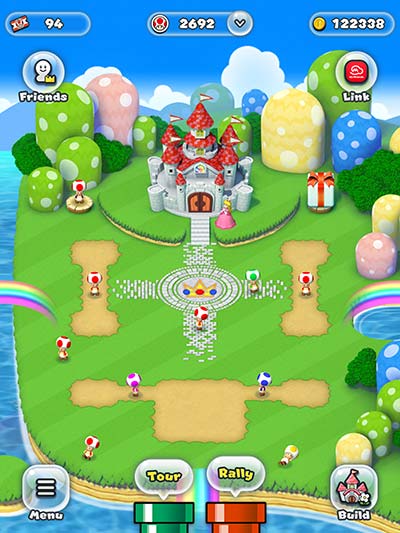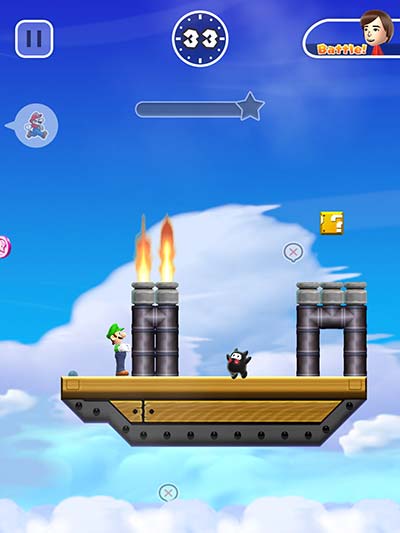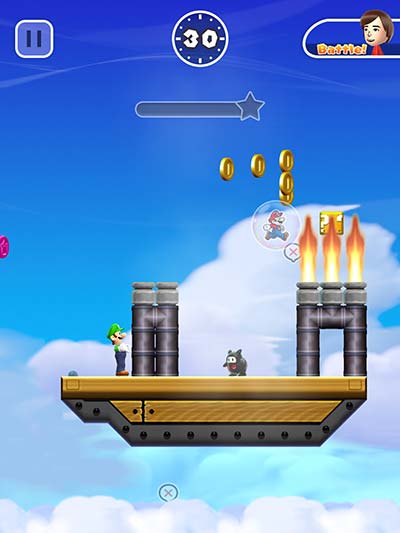Super Mario Run, an iOS game released December 15 and downloaded over 50 million times in its first five days, is a game about free will. Its three play modes reflect three different approaches to the topic.
Kingdom Builder: Free Will
The first play mode in Super Mario Run is Kingdom Builder, in which you can buy (with coins you collect elsewhere in the game) over 100 buildings and decorations to place anywhere you like on a map–think Animal Crossing or SimCity. A few buildings unlock new characters and courses, but little of what you do here affects the rest of the game.
In effect, you have consequence-less, complete free will within the constraints of the building system: you can do whatever you want.

Toad Rally: “Predeathtination”
In the second mode, Toad Rally, Mario runs on what looks like a standard course with enemies and obstacles. As in World Tour (the third play mode), he runs on his own; you only control jumping. The twist is that you’re racing against another player–with success measured not in speed but in coins and skillful jumping.
But you’re not competing live against another person; rather, you’re competing against the Mario Kart-style “ghost” of another player who’s previously completed it (aka, “asynchronous multiplayer”). However, you’re not even really competing against them–you’re competing against an artificial intelligence (AI) that plays like them based on their historical playthrough. If you play the same course against the same player repeatedly, their performance and score will vary slightly.
One thing doesn’t change with every runthrough: the deaths of the other player. And that’s where predestination (in the non-salvific sense) comes in.

In the above image, the current player as Luigi (in green, lower left) has run ahead of Mario and is waiting for him to appear on the screen. The circle with Mario in the upper left indicates that Mario is off the screen to the left and hasn’t arrived yet. Now look at the small “X” bubble near the yellow square on the right of the screen–it indicates that Mario will soon die there. (You can see a similar X bubble at the bottom of the screen, where Mario previously died.)

This image shows the scene three seconds later: Mario has met his fate, leaping to his fiery death (the bubble he’s in will transport him back to safety). Luigi can do nothing about it–no matter how many times you repeat the course, Mario will die at this spot, his algorithmic doom determined when you first decided to challenge this player.
While your character (here, Luigi) has the jumping freedom and the constant risk of death featured in World Tour, the AI competitor doesn’t–they’re always going to die at the ordained time and place.
World Tour: Partial Free Will
The third play mode, World Tour, most closely follows the traditional Mario experience of running and jumping. However, unlike a traditional Mario game, in Super Mario Run, Mario constantly runs to the right with no input from you–you can control when he jumps by tapping the screen, and that’s about it. (I’m glossing over some subtleties.) Thus, you have limited options to explore a course when Mario is running relentlessly to the right, especially compared to the near-limitless freedom that Mario usually has in his other games.

In part, this control constraint reflects iOS’s touchscreen interface. Nintendo’s Shigeru Miyamoto says, “Our feeling was that by having this iPhone game in which Mario runs automatically and all you do is jump, we would actually have quite a bit of leeway to be able to create something that’s simple and easy for anyone to play, but still has some of that challenge and skill that super players desire…. By taking that approach, it would give even beginner players an opportunity to get a taste for what’s fun about the more skilled style of Mario play.”
From a game-design perspective, the single-tap interface justifies the automatic running and meets Nintendo’s goal of satisfying both novice and expert players.
However, from a philosophical perspective, World Tour reflects a hybrid of the complete free will of Kingdom Builder and the determinism of Toad Rally. Mario runs without input from you, but Mario needs you to jump, reflecting a more-constrained system than the usual Mario game has. It’s not quite the total freedom of Kingdom Builder or a typical Mario game, but neither does it feature the deadly determinism of Toad Rally. It presents a middle ground between the other two play modes.
Conclusion
The Wired article mentioned above says that a different team developed each play mode, and I suggest that each team, by accident or design, produced a distinct exploration of free will in each mode.
As you may have guessed by now, this post is mostly an attempt to justify spending $9.99 on Super Mario Run. Also, “predeathtination” (a word, oddly, that Google has never seen).
So “mode 3” (constant right running, tap to jump) is basically Canabalt, it sounds like. A little late to the party….
Yes, though mode 3 isn’t technically an endless runner like Canabalt is–the Mario levels are fully handcrafted and only last 60-90 seconds. Replayability comes from collecting different colors of special coins (some of which rearrange the physical layout of the levels) that you can exchange to play Toad Rally.